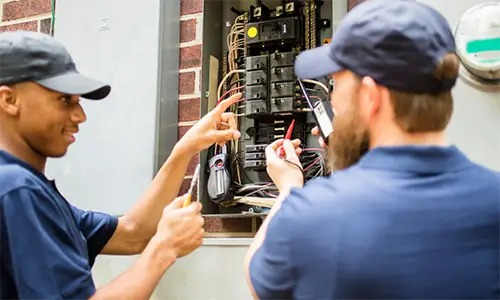Is It Possible to Switch Out a 15 Amp Breaker for a 20 Amp?
The short answer is that it’s certainly possible to replace a 15 amp breaker with a 20 amp, but should you? At first glance, it seems like a good idea and a simple item to switch out. After all, who doesn’t want more power made available in their home? If a certain circuit has been causing you issues or you’ve recently installed more appliances in your home, it may seem like a no-brainer.
For those who have been renovating their homes, making more power available may even become a necessity. Because both a 20 amp breaker and a 15 amp breaker are very commonly used in homes, some homeowners may be operating under the false assumption that replacing a 15 amp breaker with a 20 amp is a simple substitution. However, there are many details you must consider first.
Do Not Underestimate the Danger: A Circuit Breaker Is for Safety
It is key to remember that a circuit breaker’s purpose is to make your home safer. Short circuits and overloading are always potential hazards for any electrical system, which is why breakers are crucial.
When electrical currents surpass the amount of amps for which a breaker is rated, they will automatically be cut off. In your home, you can probably finda 15 amp breaker that has been designated to protect areas dedicated to wall outlets and room lighting. Meanwhile, 20 amp breakers are more likely to be located in places that are designed to support more heavy-duty electrical appliances such as microwaves.
It’s All in Your Wiring
Sometimes the numbers can be confusing for people, but a 20 amp breaker ideally works in conjunction with a 12-gauge wire while a 15 amp breaker is used to protect a 14-gauge wire. If you install a 20 amp breaker, it may very well overload a 14-gauge wire.
This, in turn, will can cause to wire to overheat prior to even tripping the breaker, which defeats the purpose of the breaker in the first place. Overheating wires have been to blame for a number of catastrophes and can lead to melted insulation and serious fires. When you have overheating wires, you are risking irreversible damage to your property — and to yourself!
Electrical Fires Are on the Rise
In 2021, there were over 24,000 electrical fires reported in the United States. Between 2013 and 2022, electrical fires ratcheted up by six percent. Some of these fires even led to fatalities. Remember that codes and regulations are there to protect you — and your home. It doesn’t take much for one spark to ignite insulation and then cause a tragic scenario. Avoid becoming one of the statistics by constantly staying on top of your home’s systems and practicing fire safety at all times.
The Few Exceptions to the Rule
If every connected device is rated for 20 amps and the whole circuit uses 12-gauge wire, you can feel confident in switching out the 15 amp breaker for a 20. However, if you have any doubt whatsoever, you must reach out to an expert to make absolutely sure. Not only is it dangerous to replace a 15 amp breaker without also adjusting the wiring, it is also against practically every safety code.
There is a reason why National Electrical Code (NEC) has published specific guidelines in regard to the limitations of both 15 and 20 amp breakers. Stay within the bounds of the law — and protect your family’s safety — by consulting the professionals when you’re not entirely confident in your system.
Is Your 15 Amp Breaker Under Pressure?
If you’ve been noticing any of the following issues, it may be time for an upgrade:
- Outlets that feel warm
- Dimmer lights when you’re running bigger appliances
- Discolored outlets
- Your breaker seems to be tripping for no reason
- You use a lot of adapters and/or extension cords
How Old Are Your Breakers?
If you live in an older home, chances are that the electricity has not been upgraded in some time. When you have an electrician take a look at all of the systems, they will be able to tell you what is still good — and what needs to go.
How Can I Improve Things Right Now?
If you want to see an immediate difference, consider moving your appliances to ensure that they’re on different circuits. When you’re putting a lot of pressure on just one circuit, it’s not surprising that a 15 amp breaker doesn’t seem like it’s doing enough. After shifting some of the electrical load around, you may notice that everything is operating more efficiently.
Help Your Home in the Long Run
For a more permanent solution to the problem, contact an electrician who can install 12-gauge wiring. Once they are satisfied that your wiring has been adequately upgraded, you will also want to have them install the new breaker with 20 amps.
Don’t Put Up with Any Malarky, Call Mister Sparky
One of the advantages of living in modern times is that we have access to electricity and an endless array of gadgets. However, unless you are an electrician, chances are that you home may need some help — especially if you’re starting to notice pesky issues like lights dimming when you use the dishwasher — or some outlets not working at all.
These are the problems that are best to address when they’re not full-scale emergencies yet. When you work with Mister Sparky, you can rest assured that the team has your best interests — and your safety — prioritized at all times. In the long run, a DIY electrical job can be very dangerous.
Also, it can end up costing you even more money if an emergency occurs. For peace of mind, you’ll want to work with the experts at Mister Sparky. This talented team can assess each specific situation and bring your home the harmony it deserves.
